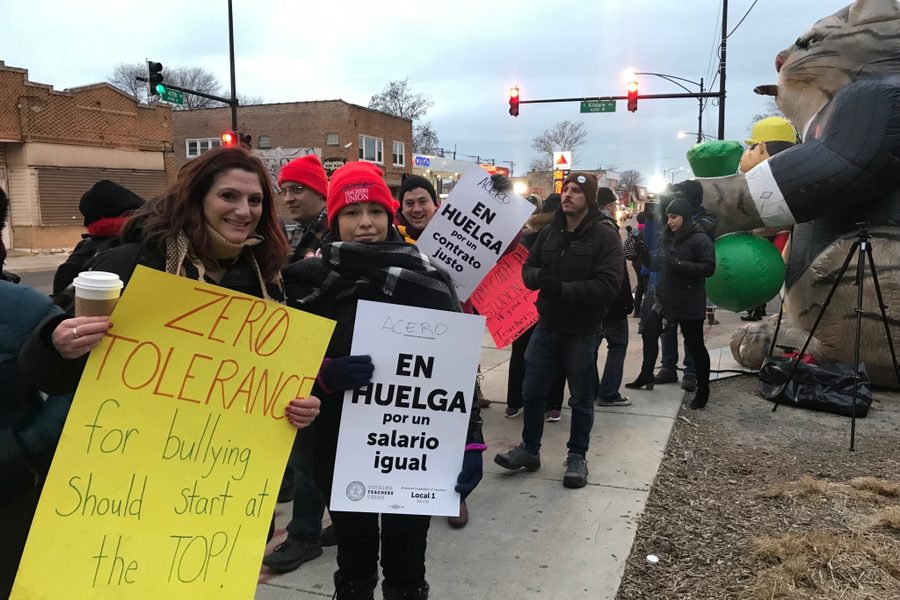‘We’re One Union’: Why Chicago Teachers Are Out On the First Charter School Strike in the Country
Rebecca Burns

After a grueling day of bargaining on Monday, teachers at Chicago’s Acero charter schools announced shortly after midnight that they were going out on the nation’s first-ever charter strike.
At Hector P. Garcia M.D. High School this morning, one of Acero’s 15 sites across the city, teachers picketed in the cold with a giant “fat cat” balloon — a classic Chicago strike mascot customized for the occasion with one inflatable paw around a bag of money and the other around a balloon teacher dressed in a red Acero T-shirt.
That image was especially resonant with many teachers given eleventh-hour information about the network’s finances. On Friday, Acero, a successor of the scandal-plagued United Neighborhood Organization (UNO), released to the teacher’s union a copy of its most recent independent audit report.
The union says that it has been requesting the audit since contract bargaining began seven months ago and that the report shows a windfall in 2018, including a $10.6 million increase in the network’s cash position.
“They’ve been crying broke, when in fact they’re flush with cash,” says Martha Baumgarten, a fifth-grade teacher at Acero’s Carlos Fuentes Elementary School and a member of the bargaining team.
A copy of the auditor’s report, reviewed by In These Times, shows that as of June 2018, the network had nearly $24 million in unrestricted cash, up from $13.2 million the previous year. That’s separate from other restricted assets, including the $4 million that Acero is required to set aside in order to pay investors in the more than $60 million in bonds issued by UNO in 2011 to finance new school buildings.
Most of the cash influx came from the Chicago Public Schools following passage of a 2017 state law that introduced a complex new school funding formula, resulting in large increases for charters.
“Their new funding came in during the fall of 2017,” says Pavlyn Jankov, a researcher at the Chicago Teacher’s Union (CTU). “But instead of putting it into the classroom, Acero decided to stockpile that cash.”
According to the CTU, which represents teachers at more than 30 Chicago charters following a merger earlier this year, Acero’s most recent contract proposal would still see charter teachers paid an average of $13,000 less than CPS teachers for 250 hours more work.
“Equal pay for equal work” is a key demand of Acero teachers, along with more diverse hiring and smaller class sizes.
In her fifth-grade classroom, Baumgarten teaches reading and writing to 32 students, Acero’s current ceiling on class sizes.
“That includes students who are very advanced and some who are just learning English,” she says. “They deserve more personalized attention.”
Her students are overwhelmingly Latinx, including many students who are undocumented or have parents without papers, she says. For that reason, another key issue for her is to win “sanctuary school” protections. While Acero’s administration has a stated policy of refusing collaboration with federal immigration enforcement, the union’s proposed language would require them to do so to the fullest extent of our law.
“When it’s written into our contract, that ensures that when it comes down to it, they’re going to stick with it,” Baumgarten tells In These Times.
In a statement released today, Acero CEO Richard L. Rodriguez’s touted the network’s roots in the Latinx community. “Our network leaders are overwhelmingly people of color raised here in Chicago or in border community,” the statement reads, adding that “the sad fact is that interests from outside our community are using our students and our schools to advance their national anti-charter school platform.”
At a board meeting this fall, Rodriguez acknowledged that Acero teachers earn less than their peers in CPS, but blamed financial constraints.
“The Chicago Public Schools operate with billions of dollars and have the full faith and credit of the city of Chicago to back them up,” he said. “Unlike CPS, we don’t have a rich uncle.”
While Acero teachers are the only group of Chicago charter educators currently out on strike, contract negotiations are proceeding between the CTU and 10 other charter operators. All 11 groups are working from a set of common proposals hashed out between teachers at different networks — a novel approach that the union hopes will bring up standards across the industry.
That kind of coordination was made possible by years of intensive charter organizing in Chicago, where charter union density is now the highest in the nation. Nationally, the American Federation of Teachers (AFT) represents approximately 7,500 educators and staff at more than 230 unionized charter schools in 15 states.
AFT President Randi Weingarten, who joined Acero teachers on the picket line this morning, says Chicago’s first-of-its-kind strike holds lessons for the importance of solidarity between teachers in charters and public schools.
“All too often, the business interests are the ones acting in alignment,” says Weingarten. “So that’s what these teachers are doing — overcoming divide and conquer, saying, ‘we’re one union.’”
Rebecca Burns is In These Times’ housing editor and an award-winning investigative reporter. Her work has appeared in Business Insider, the Chicago Reader, the Intercept, ProPublica Illinois and other outlets.







